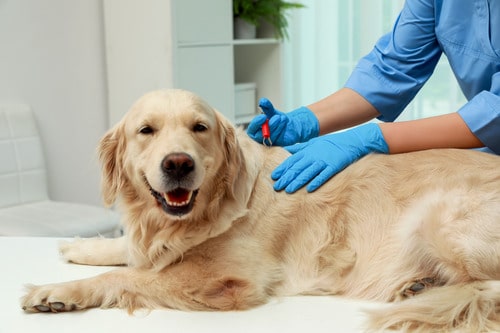Ticks are more than just a nuisance. They can transmit serious diseases that put your dog’s health at risk. If you’ve discovered a tick on your pet, you may be wondering how to remove a tick from a dog safely. While it can feel overwhelming at first, knowing what to watch for and when to seek veterinary help makes all the difference. At Arrowhead Animal Hospital in Westminster, CO, we can guide you through what you need to know about ticks, how they affect your pet, and when it’s time to call in the experts. If you ever have questions about your dog’s health, call us at (303) 469-1616 or book an appointment online.
Why Ticks Are a Concern for Dogs
Ticks are parasites that attach to the skin and feed on blood. Unfortunately, they are not just irritating. They can transmit illnesses that may have long-term effects on your dog’s health. Learning how to remove a tick from a dog is only part of the equation; understanding the risks they pose helps you stay proactive.
Ticks can carry pathogens such as those responsible for Lyme disease, Rocky Mountain spotted fever, and ehrlichiosis. These diseases may cause symptoms ranging from joint pain and fatigue to more severe complications if left untreated. Because ticks thrive in tall grass, wooded areas, and even suburban yards, your pet may encounter them during daily walks or outdoor play.
Why Prevention Matters
While knowing how to remove a tick from a dog is important, preventing exposure in the first place reduces the risk of disease. Routine tick checks, especially after outdoor activity, combined with veterinary-recommended preventives, help protect your dog year-round.
How Ticks Attach to Dogs
Understanding how ticks behave makes it easier to grasp why prompt removal is so important. Ticks often crawl onto a dog from grass or brush and seek out areas with thinner skin, such as around the ears, between toes, or under collars. Once they find a spot, they use specialized mouthparts to embed themselves and begin feeding. Ticks can remain attached for several days, increasing the likelihood of disease transmission the longer they are in place. This is why learning how to remove a tick from a dog safely and promptly is emphasized by veterinarians.
Common Signs a Tick May Be Attached
- Red or irritated skin where the tick is feeding
- Small lumps or bumps that feel different from your dog’s normal skin
- Excessive scratching or licking at a specific spot
- Visible dark specks on the skin or fur
If you notice any of these signs, check carefully for ticks and reach out to your veterinarian if you’re unsure what you’re seeing.
Why Proper Tick Removal Matters
Some pet owners may wonder why it’s not enough to just brush or scratch a tick off. The reason is simple: improper removal can leave parts of the tick behind, which may increase irritation or infection risk. Because ticks attach firmly with their mouthparts, knowing how to remove a tick from a dog correctly minimizes complications. Additionally, squeezing or mishandling a tick may increase the chance of transmitting disease. That’s why veterinary professionals recommend safe techniques and encourage pet parents to contact their veterinarian if they feel uncertain.
How To Remove a Tick from a Dog Safely
Learning how to remove a tick from a dog involves understanding what not to do as much as what to do. While there are myths about using petroleum jelly, matches, or household items to make a tick detach, these methods are not safe and may cause harm. When you bring your dog to a veterinarian, they use sterile tools and techniques to ensure the tick is removed fully and safely. While it’s natural to want to take immediate action, contacting your veterinary team is the best way to handle tick removal and reduce potential health risks.
What Happens After Removal
Even after a tick is removed, your veterinarian may recommend monitoring your dog closely for signs of illness in the following weeks. This is because some tick-borne diseases may not show symptoms right away. Routine testing and follow-up care ensure that if your dog was exposed, treatment can begin promptly.
Why Veterinary Support is Best
Pet parents often search for how to remove a tick from a dog because it seems like something that can be done at home. However, veterinary support offers several key benefits:
- Complete removal: Veterinarians ensure all parts of the tick are safely extracted.
- Disease protection: Your vet can recommend testing for common tick-borne illnesses.
- Ongoing prevention: A veterinary visit is the perfect time to discuss year-round tick preventives.
- Peace of mind: You can feel confident knowing your dog received professional care.
At Arrowhead Animal Hospital, our team is always glad to answer questions, provide safe removal, and protect your dog’s long-term health.
Tips for Preventing Future Tick Problems
After learning how to remove a tick from a dog, prevention naturally becomes the next focus. Preventing tick bites protects not just against the irritation of ticks themselves, but also the diseases they may transmit.
Steps You Can Take at Home
- Regular tick checks: Run your hands over your dog’s body after walks or outdoor play, paying special attention to hidden areas.
- Yard maintenance: Keep grass trimmed and remove leaf litter where ticks thrive.
- Pet-safe products: Ask your veterinarian about collars, topical solutions, or oral preventives suited for your dog’s lifestyle.
The Role of Veterinary Preventives
While environmental measures help, veterinary-prescribed preventives are the most reliable way to stop ticks from latching on. These products are tailored to your dog’s weight, age, and health status, ensuring safe and effective protection. Discussing these options with your veterinarian is the best way to choose the right plan.
When Should You Call Arrowhead Animal Hospital?
Even though you now know how to remove a tick from a dog, professional support offers reassurance and additional protection. If you discover a tick and aren’t sure how long it has been attached, or if your dog develops unusual symptoms such as lethargy, loss of appetite, or joint stiffness, contacting your veterinarian is essential. At Arrowhead Animal Hospital in Westminster, CO, we provide compassionate care, safe tick removal, and guidance on long-term prevention. Call us today at (303) 469-1616 or book an appointment online to protect your dog’s health and stay ahead of tick-related concerns.





